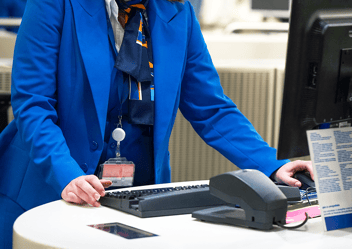Managing lost and found operations can be a challenging task, especially in large venues like airports, hotels, theme parks, and stadiums. Over time, storage areas overflow with unclaimed items, and the process of manually matching lost item reports to found items becomes painstakingly slow and prone to human error.
Especially for industries like hospitality, AI offers a smarter, more efficient way to tackle the complexities of lost and found management, enabling quicker, more accurate matches and improving the overall experience for both employees and customers.
So, why do manual lost and found processes fall short, and how does AI-powered software help raise the bar?
The limitations of manual lost and found
Traditional lost and found systems rely on employees to catalog, sort, and match items to their rightful owners. While this approach can work in smaller settings with few lost items, it quickly becomes unmanageable in high-traffic locations.
Key challenges include:
- Lack of consistency — Manual efforts rely on creating item descriptions, which can vary significantly between team members. For example, one team member may describe a phone as “Samsung Galaxy phone with a cracked screen in a blue case,” while another might simply label it as "Samsung phone." This inconsistency can lead to missed matches and confusion.
- Operational inefficiencies — Managing spreadsheets or relying on email threads can easily spiral into chaos, especially for teams like security, hospitality, and housekeeping, who have other critical responsibilities. Without a centralized system, lost and found tasks may fall through the cracks due to the complexity and volume of work these teams handle daily.
- Negative brand perception — When customers don't get their items back, they feel frustrated, even if the rest of their experience with your business was positive. An unresolved lost and found situation may even result in negative reviews or a damaged brand reputation.
To address these limitations, businesses are turning to automation and AI to create a seamless lost and found experience.
Speeding up item entry
One of the core functions of any lost and found system is logging items that are turned in, and AI-powered tools simplify and accelerate this process significantly.
For example, with AI object detection, employees can snap a photo of a found item, and AI will analyze the image and generate a detailed description, including specifics like color, brand, and item type. Optical character recognition (OCR) also allows AI to capture identifying details from photographs, such as serial numbers or names, so they can be used as a unique identifier.
This process ensures that item entries are accurate, consistent, and detailed, drastically improving the quality of the lost and found database — while also saving employees valuable time on manual data entry.
Improving match accuracy
Some lost and found software, like Reunitus, leverages AI to deliver faster and more accurate matches.
By analyzing details such as colors, brands, logos, serial numbers, and even phrases or names on ID cards, our system produces fast, highly accurate results. Instead of team members spending minutes scrolling through a database or even longer physically searching through boxes, AI can identify potential matches in seconds.
Using AI tools to enter information in lost and found databases not only increases the likelihood of accurate matches but also saves employees valuable time and helps reunite customers with their belongings much faster.
Streamlining every step
No one wants to wrestle with a complicated lost and found platform that requires manual effort at every turn. AI simplifies the process into clear, actionable steps:
- Item found: Someone finds an item and turns it in.
- Photo taken: A team member snaps a photo of the item.
- AI analysis: Using computer vision object detection, the software suggests key identifiers, such as color, brand name, item type, and a brief description.
- Details confirmed: The team member confirms or adjusts the AI-generated descriptions and adds any additional details, like where and when the item was found, serial numbers, or unique identifiers (e.g., stickers, keychains, scratches).
- Matching process: The algorithm searches lost item reports in the background for potential matches, while team members are free to tackle other tasks.
- Match review: The system presents potential matches to the team member, who makes the final determination on whether it’s a match.
- Reunification: Communication with the owner begins. In some software, this process can even be automated to speed up the process.
Beyond reunification, AI can also analyze trends, such as identifying areas in your venue where items are frequently lost. For example, in an airport, AI might reveal that passengers often misplace items near security checkpoints or boarding gates, enabling you to improve signage in those areas to help prevent future losses.
Revolutionizing lost and found management
AI-powered tools can transform lost and found management by boosting return rates, cutting resolution times by over half, and turning a frustrating process into a powerful driver of customer loyalty and trust.
At Reunitus, we specialize in innovative lost and found solutions, helping businesses across industries improve return rates — some by over 500%. Our AI-powered systems ensure that you spend less time managing items and more time delivering outstanding customer experiences.
See how AI-powered lost and found software can transform your operations. Get in touch.

.png?width=352&name=Untitled%20design%20(32).png)
.png?width=352&name=Untitled%20design%20(31).png)


.png?width=352&name=How%20Lost%20and%20Found%20Management%20Systems%20Can%20Improve%20Customer%20Experience%20(3).png)